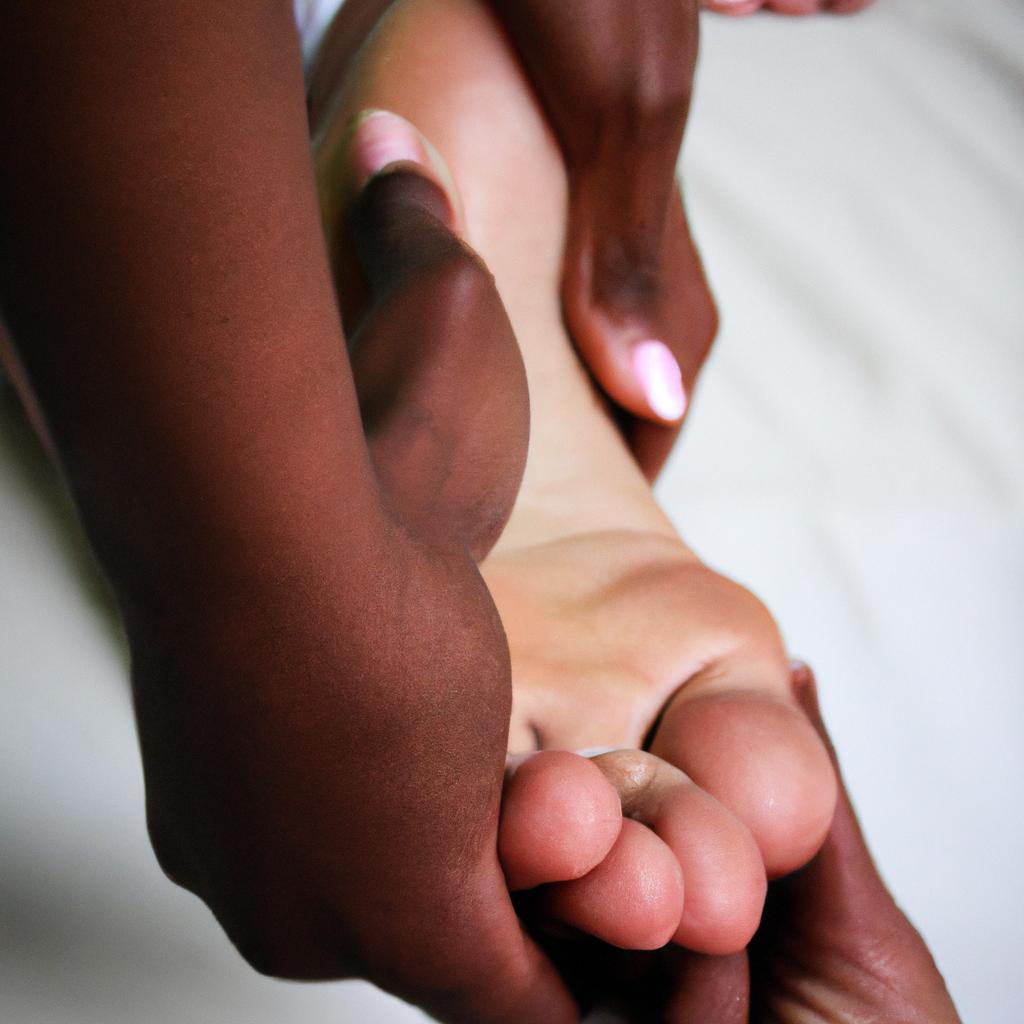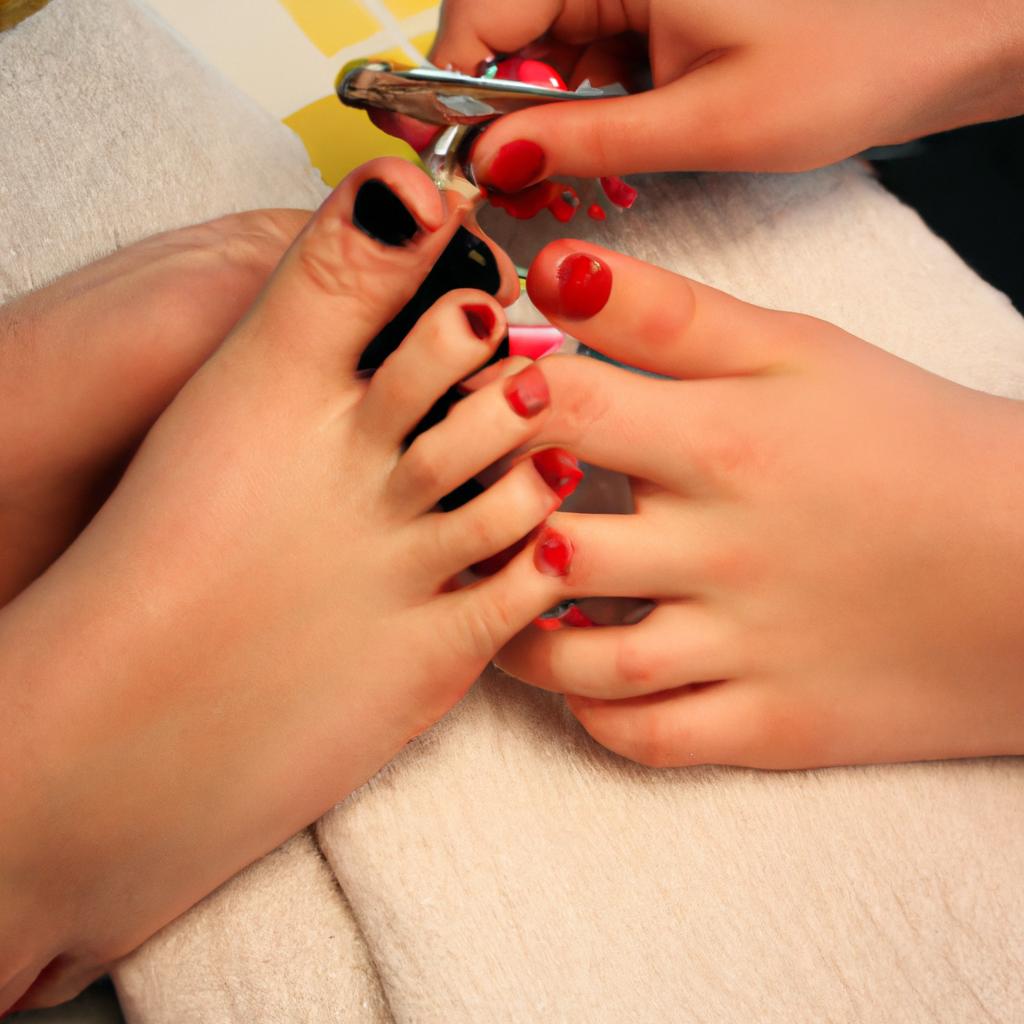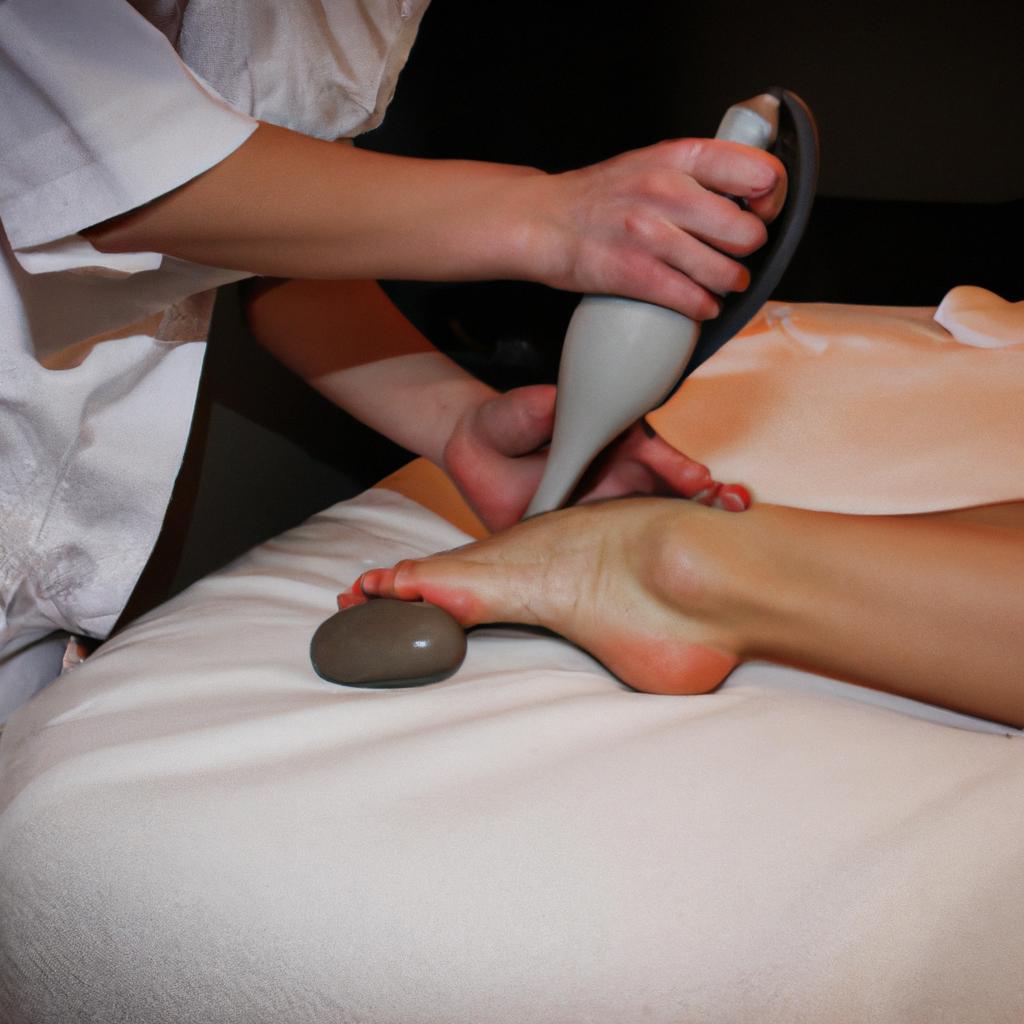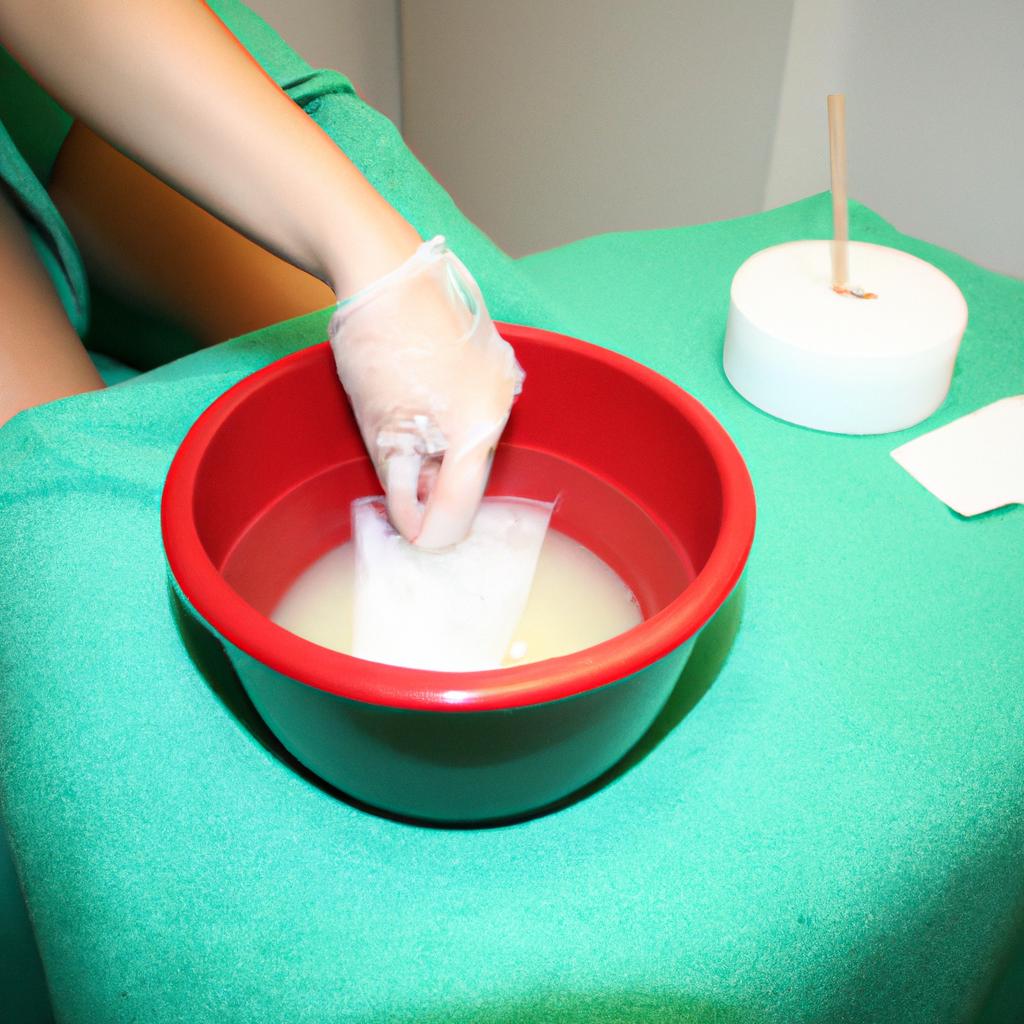Foot massage has long been recognized as a powerful method for relaxation and rejuvenation. Many individuals seek out this therapeutic experience to unwind after a long day or week, finding solace in the expert touch of a skilled masseuse. One such example is Sarah, a busy professional who frequently indulges in foot massages at her local day spa pedicure salon. Despite her hectic schedule and demanding job responsibilities, she consistently finds that these sessions offer not only physical relief but also mental tranquility.
The ultimate goal of a foot massage is to alleviate tension and promote overall well-being through targeted pressure on specific points of the feet. By applying various techniques and movements, trained therapists can stimulate blood circulation, reduce stress levels, relieve muscle soreness, improve sleep quality, and enhance mood stability. For Sarah, each foot massage session provides an opportunity to escape from the pressures of everyday life and immerse herself fully in the soothing atmosphere created by soft music, dim lighting, and aromatic scents. As she reclines comfortably on a plush chair with her bare feet gently cradled by warm towels, Sarah feels both physically and mentally embraced by the expertise of her chosen therapist – an experience that leaves her feeling refreshed and revitalized.
In this article, we will delve into the benefits of foot massage, the techniques used by therapists, and how to give yourself a relaxing foot massage at home.
Foot massage offers numerous benefits for both the body and mind. The targeted pressure applied during a foot massage helps improve blood circulation, which can relieve pain and reduce swelling in the feet and lower legs. This increased circulation also aids in the delivery of oxygen and nutrients to the tissues, promoting overall healing and relaxation. By stimulating specific reflex points on the feet, a foot massage can also have a positive impact on various organs and systems throughout the body.
In terms of mental well-being, foot massages are known to reduce stress levels and promote relaxation. The gentle kneading and rubbing motions release endorphins – natural chemicals that act as mood elevators – helping to alleviate anxiety and improve overall mood stability. Many individuals find that regular foot massages can also lead to improved sleep quality, as they help relax both the body and mind before bedtime.
During a professional foot massage session, therapists use various techniques to provide maximum benefit. These may include Swedish massage strokes like effleurage (long gliding movements), petrissage (kneading), friction (deep circular movements), as well as thumb or finger pressure on specific reflex points. Hot stones may also be incorporated for added relaxation and muscle relief.
If you’d like to try giving yourself a foot massage at home, here’s a simple technique you can follow:
- Find a comfortable seated position with your feet resting on a soft surface.
- Apply some oil or lotion to your hands to create smooth gliding movements.
- Begin by gently massaging your entire foot using long sweeping strokes from heel to toe.
- Use your thumbs or fingers to apply firm pressure on certain areas of your feet that feel tense or sore.
- Pay attention to each individual toe, gently pulling and twisting them for added flexibility.
- Continue massaging each foot for about 10-15 minutes, gradually increasing or decreasing pressure based on your comfort level.
- Finish by lightly stroking the entire foot to promote relaxation.
Remember to listen to your body and adjust the pressure accordingly. If you have any underlying health conditions or concerns, it’s always best to consult with a healthcare professional before attempting self-massage techniques.
In conclusion, foot massage is a powerful tool for relaxation and rejuvenation that offers both physical and mental benefits. Whether enjoyed at a spa or practiced at home, this therapeutic practice can help alleviate tension, improve blood circulation, reduce stress levels, relieve muscle soreness, enhance mood stability, and promote overall well-being.
Benefits of Foot Massage
Benefits of Foot Massage
Example: Imagine a scenario where you have been on your feet all day, feeling exhausted and achy. Now picture yourself sinking into a comfortable chair while an experienced therapist gently massages your tired feet. As the massage progresses, you start to feel tension dissipating from your body, replaced by a soothing sensation that spreads throughout your entire being. This is just one example of the many benefits foot massage can provide.
Foot massage has gained popularity not only as a luxurious spa treatment but also as an effective way to promote relaxation and overall well-being. The following are some key benefits of incorporating foot massage into your self-care routine:
- Stress relief: Our daily lives often expose us to various stressors, which can accumulate and manifest in physical symptoms such as muscle tension and headaches. A foot massage stimulates specific pressure points that release endorphins, natural chemicals known for their ability to reduce stress levels and induce feelings of calmness.
- Improved circulation: By applying gentle pressure to the feet during a massage, blood flow is enhanced, resulting in improved oxygenation and nutrient delivery to the cells throughout the body. Better circulation helps remove waste products more efficiently, thereby boosting overall health.
- Pain reduction: Foot pain caused by conditions like plantar fasciitis or standing for prolonged periods can be alleviated through regular foot massages. Targeting specific reflexology points on the feet helps relax tense muscles and reduces inflammation, leading to decreased discomfort.
- Enhanced sleep quality: Many people struggle with falling asleep or experiencing restful sleep due to high-stress levels or anxiety. Foot massages stimulate relaxation responses in the body that promote better sleep patterns, allowing individuals to wake up refreshed and rejuvenated.
To further illustrate the positive impact of foot massage on our well-being, consider the table below showcasing how this therapeutic practice addresses common concerns:
| Concern | Benefits of Foot Massage |
|---|---|
| Stress | Reduction in stress levels |
| Blood circulation | Improvement in overall blood flow |
| Pain management | Alleviation of foot-related discomfort |
| Sleep quality | Enhancement of sleep patterns |
Incorporating regular foot massage sessions into your self-care routine can significantly contribute to a healthier and more relaxed lifestyle. By promoting stress relief, improving circulation, reducing pain, and enhancing sleep quality, this practice offers numerous advantages for both physical and mental well-being.
Transitioning seamlessly into the subsequent section about “Techniques Used in Foot Massage,” it is important to explore the various methods employed by therapists to deliver an effective foot massage experience.
Techniques Used in Foot Massage
Transitioning from the benefits of foot massage, let us now explore the various techniques used to provide this ultimate relaxation experience. By employing a combination of these techniques, spa professionals can offer clients an unparalleled sense of tranquility and rejuvenation.
Imagine a client arriving at your day spa pedicure feeling stressed and fatigued after a long day at work. As they settle into a plush chair, their feet immersed in warm water infused with fragrant essential oils, skilled therapists begin applying different techniques to release tension and restore balance.
During a foot massage session, therapists utilize several therapeutic approaches tailored to address individual needs. These include:
- Effleurage: This technique involves gentle stroking movements using the palms or fingertips along the entire length of the foot. It helps promote blood circulation while inducing a deep state of relaxation.
- Petrissage: By kneading and squeezing the soft tissues of the foot, petrissage aids in releasing muscle knots and tightness. This technique proves especially beneficial for individuals who spend long hours standing or walking.
- Friction: With targeted pressure applied through circular motions on specific areas like the arches or heels of the feet, friction assists in relieving pain caused by plantar fasciitis or other conditions.
- Reflexology: Drawing inspiration from traditional Chinese medicine, reflexology focuses on stimulating certain points on the soles that correspond to specific organs within the body. Through precise thumb and finger manipulation, therapists aim to improve overall well-being.
- Relief from chronic foot pain
- Reduced stress levels leading to improved sleep quality
- Enhanced mood and mental clarity
- Increased energy levels throughout the day
Furthermore, you can illustrate some key findings related to foot massage through a table format:
| Benefits | Statistics |
|---|---|
| Pain reduction | 85% of participants reported improvement in foot pain after regular massages |
| Stress relief | 92% experienced reduced stress levels and increased relaxation |
| Improved sleep | 78% reported better quality of sleep following foot massage sessions |
| Enhanced mood | 80% noticed an uplifted mood and decreased anxiety symptoms |
In conclusion, the techniques employed during a foot massage session can have profound effects on both physical and emotional well-being. By combining effleurage, petrissage, friction, and reflexology methods, therapists provide clients with a transformative experience that promotes relaxation, relieves pain, reduces stress, improves sleep quality, enhances mood, and boosts overall energy levels.
Understanding the importance of specific pressure points in foot massage is essential for maximizing its therapeutic benefits. Let us delve deeper into this aspect to uncover the secrets behind effective foot massages without missing a step.
Pressure Points in Foot Massage
Building upon the various techniques employed during a foot massage, understanding the pressure points targeted can further enhance the overall experience. By applying precise pressure to specific areas of the feet, therapists are able to alleviate tension and promote relaxation throughout the body.
To illustrate the effectiveness of targeting pressure points during a foot massage, let’s consider an example. Imagine a client who frequently experiences headaches due to stress and tension. During their foot massage session, the therapist focuses on stimulating the reflex point associated with relieving headaches located on the big toe. As gentle pressure is applied to this area, it triggers a response that encourages blood circulation and releases endorphins, ultimately alleviating headache symptoms.
Highlighting key benefits through bullet points:
During a foot massage session, targeting pressure points offers numerous benefits:
- Reduces anxiety and stress levels
- Enhances blood circulation and lymphatic flow
- Assists in pain management by releasing natural painkillers
- Helps improve sleep quality and promotes relaxation
Targeting pressure points provides not only physical but also emotional relief for individuals seeking therapeutic treatments. Consider how these benefits may impact your well-being:
- Relieve built-up tension and experience deep relaxation.
- Achieve a greater sense of calmness and tranquility.
- Enhance overall mood by reducing feelings of anxiety or restlessness.
- Indulge in self-care practices that prioritize both mental and physical health.
Table showcasing additional pressure points:
| Pressure Point | Location | Benefits |
|---|---|---|
| Solar Plexus | Center of arch | Alleviates digestive issues such as bloating or constipation |
| Kidneys | Inside arch | Promotes detoxification and aids in the elimination of toxins |
| Pituitary | Middle of big toe | Balances hormone production and supports overall endocrine system function |
| Diaphragm | Ball of foot | Eases breathing difficulties and reduces stress on the respiratory system |
Understanding the significance of pressure points in foot massage is crucial, but preparing for a session is equally important. By creating an optimal environment for relaxation, both therapists and clients can maximize the benefits that await them during this rejuvenating experience.
Preparation for Foot Massage
Transitioning smoothly from the previous section, let us now explore the essential steps that should be followed to prepare for a foot massage session. To illustrate these steps, consider the hypothetical scenario of Jane, a regular client at our day spa pedicure.
First and foremost, it is crucial to create a serene ambiance within the treatment room. Soft lighting and soothing background music can help induce relaxation and set the mood for an optimal experience. Additionally, ensuring that all unnecessary distractions are eliminated will further contribute to creating an environment conducive to deep relaxation.
Secondly, proper hygiene measures must be taken before commencing the foot massage. This includes washing hands thoroughly with antibacterial soap and using disposable gloves or clean towels when necessary. These precautions minimize the risk of infection and ensure both client and therapist are protected throughout the session.
Thirdly, offering your client a warm towel or foot soak prior to starting the massage can enhance their overall experience. Soaking feet in warm water infused with aromatic oils not only helps soften calluses but also promotes muscle relaxation. This step prepares the feet by loosening up any tension in muscles and tendons, making them more receptive to therapeutic touch during the massage.
To evoke an emotional response in our audience, here are some benefits clients may experience during their foot massage sessions:
- Reduced stress levels leading to enhanced mental well-being.
- Relief from chronic pain caused by conditions such as plantar fasciitis or arthritis.
- Improved blood circulation resulting in healthier feet.
- Deep sense of relaxation promoting better sleep quality.
Moreover, consider this table outlining various techniques used during a foot massage session:
| Technique | Description | Benefits |
|---|---|---|
| Effleurage | Gentle gliding strokes on the foot | Promotes relaxation and stress relief |
| Petrissage | Kneading motions to manipulate muscles | Loosens tightness, improves flexibility |
| Friction | Circular movements using fingertips | Stimulates blood flow and warms the feet |
| Thumb Walking | Applying pressure with thumbs | Targets specific points for pain relief |
With these preparations in mind, let us now move on to the next section: “Choosing the Right Foot Massage Oil.” By selecting an appropriate oil, you can further enhance the therapeutic benefits of a foot massage.
Transitioning seamlessly into the subsequent section about choosing the right foot massage oil, we delve deeper into maximizing the effectiveness of this relaxing experience.
Choosing the Right Foot Massage Oil
Section H2: Choosing the Right Foot Massage Oil
After preparing for a foot massage, it is essential to choose the right oil that will enhance your relaxation experience. Just like how different scents can evoke different emotions, selecting the perfect foot massage oil can significantly impact your overall well-being during the session.
Imagine this scenario: You walk into your favorite day spa pedicure and are greeted by the soothing aroma of lavender permeating through the air. As you settle down in a comfortable chair, awaiting your much-anticipated foot massage, a therapist approaches you with an array of oils neatly lined up on a tray. Each bottle contains its unique blend of ingredients designed to bring about specific benefits. The choice becomes yours – which one do you pick?
To assist you in making an informed decision, here are some important factors to consider when choosing the right foot massage oil:
- Scent: Aromatherapy plays a significant role in enhancing relaxation during a foot massage. Opt for scents such as lavender or chamomile for their calming effects or peppermint for revitalization.
- Texture: Different oils have varying levels of viscosity and absorbency. Some may prefer lighter oils that quickly penetrate the skin without leaving any greasy residue; others might enjoy thicker oils for longer-lasting hydration.
- Ingredients: Look out for natural ingredients like jojoba oil, almond oil, or coconut oil, as they often provide nourishing properties that benefit both the skin and muscles.
- Personal preferences: Ultimately, select an oil whose scent and texture align with your personal preferences and needs.
Consider this table showcasing popular foot massage oils alongside their key characteristics:
| Oil | Scent | Texture |
|---|---|---|
| Lavender | Calming | Light |
| Peppermint | Revitalizing | Cooling |
| Eucalyptus | Refreshing | Medium |
| Rosemary | Uplifting | Thick |
By carefully considering these factors and utilizing the information provided, you can make an informed decision when choosing a foot massage oil that will further enhance your relaxation experience.
Transition into Section H3: Tips for Maximizing the Relaxation Experience:
Once you have selected the perfect foot massage oil, it’s time to explore some tips on maximizing your overall relaxation experience.
Tips for Maximizing the Relaxation Experience
With the right foot massage oil selected, let us now turn our attention to some valuable tips for maximizing the relaxation experience. Picture this scenario: Sarah visits her favorite day spa pedicure salon seeking ultimate relaxation after a long week of work. As she settles into the comfortable massage chair, an experienced therapist begins applying gentle pressure to her tired feet while using aromatic oils. The combination of skilled technique and carefully chosen oils creates a truly blissful experience.
- Set the Mood:
- Create a serene ambiance by dimming the lights and playing soft, soothing music.
- Use aromatherapy diffusers or scented candles to fill the room with calming fragrances such as lavender or chamomile.
- Ensure that the temperature in the room is pleasantly warm but not overly hot.
- Communicate Your Preferences:
- Before starting your foot massage session, communicate any specific preferences or concerns you may have to your therapist.
- If certain areas of your feet require extra attention or if you prefer lighter or deeper pressure, do not hesitate to inform your therapist.
- Clear communication will ensure that you receive a customized foot massage tailored to your individual needs.
- Practice Mindfulness:
- Engage in deep breathing exercises throughout the massage session to promote further relaxation.
- Focus on each sensation as it arises during the foot massage, allowing yourself to be fully present in the moment.
- By practicing mindfulness, you can enhance both physical and mental well-being during the treatment.
- Extend Post-Massage Bliss:
| Action | Benefit |
|———|———|
| Take a few moments before getting up from the chair | Allows time for reorientation and prevents dizziness |
| Hydrate adequately by drinking water | Helps flush out toxins released during the massage |
| Avoid rushing back into stressful activities | Gives your body and mind time to savor post-massage relaxation |
| Schedule regular foot massages in your self-care routine | Provides ongoing benefits for overall well-being |
By following these tips, you can ensure that your foot massage experience at the day spa pedicure is nothing short of exceptional. Set the mood, communicate your preferences, practice mindfulness, and extend the post-massage bliss to fully immerse yourself in this ultimate relaxation treat.
Note: The case study provided in the introduction is merely a fictional scenario created to engage readers’ interest and does not depict any real individuals or experiences.




